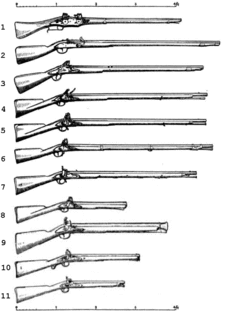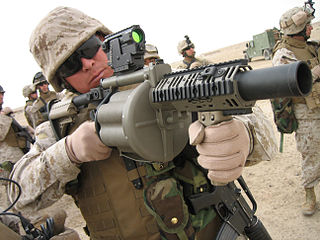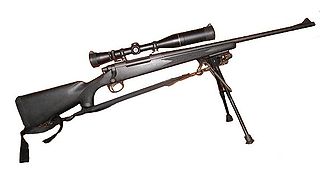
A carbine, from French carabine, is a long gun firearm but with a shorter barrel than a rifle or musket. Many carbines are shortened versions of full-length rifles, shooting the same ammunition, while others fire lower-powered ammunition, including types designed for pistols.

A firearm is a portable gun that inflicts damage on targets by launching one or more projectiles driven by rapidly expanding high-pressure gas produced chemically by exothermic combustion (deflagration) of propellant within an ammunition cartridge. If gas pressurization is achieved through mechanical gas compression rather than through chemical propellant combustion, then the gun is technically an air gun, not a firearm.

Gun safety rules and practice recommendations are intended to avoid accidental discharge or negligent discharge, or the consequences of firearm malfunctions. Their purpose is to eliminate or minimize the risks of unintentional death, injury or property damage caused by improper possession, storage or handling of firearms. There were 47,000 unintentional firearm deaths worldwide in 2013.

A shotgun is a firearm that is usually designed to be fired from the shoulder, which uses the energy of a fixed shell to fire a number of small spherical pellets called shot, or a solid projectile called a slug. Shotguns come in a wide variety of sizes, ranging from 5.5 mm (.22 inch) bore up to 5 cm (2.0 in) bore, and in a range of firearm operating mechanisms, including breech loading, single-barreled, double or combination gun, pump-action, bolt-, and lever-action, revolver, semi-automatic, and even fully automatic variants.
The Star Trek fictional universe contains a variety of weapons, ranging from missiles to melee. The Star Trek franchise consists primarily of several multi-season television shows and a dozen movies, as well as various video games and inspired merchandise. Many aspects of the fictional universe impact modern popular culture, especially the lingo and the idea of a spacecraft launching space torpedoes and firing lasers, and have had a wide influence in the late 20th to early 21st century. Star Trek is popular enough that its science fiction concepts have even been studied by real scientists, and NASA described its science in relation to the real world as "entertaining combination of real science, imaginary science gathered from lots of earlier stories, and stuff the writers make up week-by-week to give each new episode novelty." For example, NASA noted that the Star Trek "phasers" were a fictional extrapolation of real-life lasers, and compared them to real-life microwave based weapons that have a stunning effect.

A cartridge is a type of pre-assembled firearm ammunition packaging a projectile, a propellant substance and an ignition device (primer) within a metallic, paper or plastic case that is precisely made to fit within the barrel chamber of a breechloading gun, for the practical purpose of convenient transportation and handling during shooting. Although in popular usage the term "bullet" is often used to refer to a complete cartridge, it is correctly used only to refer to the projectile.

Flintlock is a general term for any firearm that uses a flint striking ignition mechanism. The term may also apply to a particular form of the mechanism itself, also known as the true flintlock, that was introduced in the early 17th century, and rapidly replaced earlier firearm-ignition technologies, such as the matchlock, the wheellock, and the earlier flintlock mechanisms.
An air gun is any kind of gun that launches projectiles pneumatically with compressed air or other gases that are pressurized mechanically without involving any chemical reactions, in contrast to a firearm, which pressurizes gases chemically via an exothermic oxidation (deflagration) of combustible propellants which generates propulsive energy by breaking molecular bonds. Both the long gun and handgun forms typically propel metallic projectiles, that are either diabolo-shaped pellets, or spherical shots called BBs. Certain types of air guns may also propel darts or arrows.

The VSS, also called the Vintorez, is a suppressed sniper rifle that uses a heavy subsonic 9×39mm SP5 cartridge and armor-piercing SP6 cartridge. It was developed in the late 1980s by TsNIITochMash and manufactured by the Tula Arsenal. It is issued primarily to Spetsnaz units for undercover or clandestine operations, a role made evident by its ability to be stripped down for transport in a specially fitted briefcase.

In current usage a riot gun or less-lethal launcher is a type of firearm that is used to fire "non-lethal" or "less-lethal" ammunition for the purpose of suppressing riots. Less-lethal launchers may be special purpose firearms designed for riot control use, or standard firearms, usually shotguns and grenade launchers, adapted to riot control use with appropriate ammunition. The ammunition is most commonly found in 12 gauge shotguns and 37mm/40 mm grenade launchers.

The Remington Model 700 is a series of bolt-action centerfire rifles manufactured by Remington Arms since 1962. It is a development of the Remington 721 and 722 series of rifles, which were introduced in 1948. The M24 and M40 military sniper rifles used by the US Army and USMC are both based on the Model 700 design.
The LR 300 is an American rifle and conversion kit designed by gunsmith Allan Zitta and manufactured by Z-M Weapons. The LR stands for "Light Rifle" and 300 is for 300 meters, the effective range of the rifle with a standard 55-grain FMJ bullet. It is based on the AR-15 and is broadly similar to the United States service rifle, the M16.

A Leyden ball is a fictional bullet used in the nineteenth century Jules Verne science fiction novel, Twenty Thousand Leagues Under the Sea. It contains a capacitance charge of electrical energy, which discharges instantaneously upon the bullet's impact.
The Colt New Model Revolving rifles were early repeating rifles produced by the Colt's Manufacturing Company 1856 until 1864. They were mainly based upon the Colt Model 1855 Sidehammer Pocket Revolver developed by Elisha K. Root.

The Springfield Armory M6 Scout is a .22 Hornet over .410 bore combination gun that is virtually identical to the original M6 Aircrew Survival Weapon. It is also made in .22 Long Rifle over .410 bore and .22 Magnum over .410 bore. The Scouts were made with 18.25 inches (46.4 cm) barrels, opposed to the to original's 14 inches (36 cm) barrel length, to comply with National Firearms Act. The later models had large over-sized trigger guards and Picatinny rails for mounting a wide range of sights and scopes. They come in stainless steel or with a Parkerized finish.

A baton or truncheon or kosh is a roughly cylindrical club made of wood, rubber, plastic or metal. It is carried as a compliance tool and defensive weapon by law-enforcement officers, correctional staff, security guards and military personnel. In many cultures, they are highly symbolic of law enforcement and are rarely used with the intention to kill.

A gun is a ranged weapon typically designed to pneumatically discharge projectiles that are solid but can also be liquid or even charged particles and may be free-flying or tethered.

A raygun is a science fiction particle-beam weapon that fires what is usually destructive energy. They have various alternate names: ray gun, death ray, beam gun, blaster, laser gun, laser pistol, phaser, zap gun, etc. In most stories, when activated, a raygun emits a ray, typically visible, usually lethal if it hits a human target, often destructive if it hits mechanical objects, with properties and other effects unspecified or varying.

Pistol-whipping or buffaloing is the act of using a handgun as a blunt weapon, wielding it as if it were a club or baton. Such a practice dates to the time of muzzle loaders, which were brandished in such fashion in close-quarters combat once the weapon's single projectile had been expended.

















